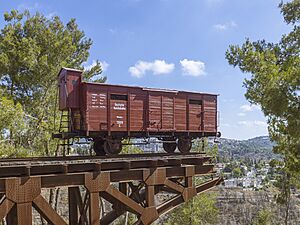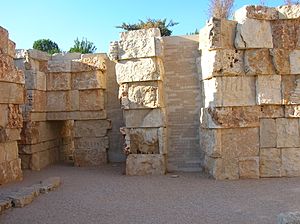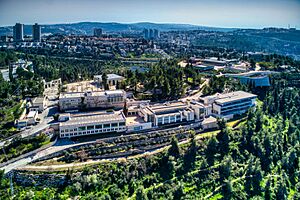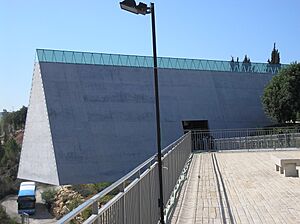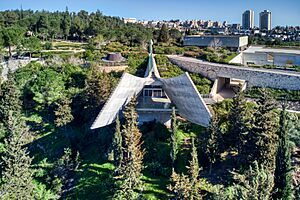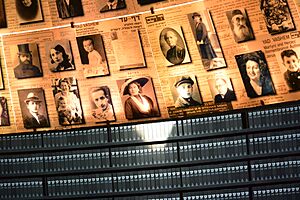Yad Vashem facts for kids
| יָד וַשֵׁם | |
 |
|

Aerial view of Yad Vashem
|
|
| Established | 19 August 1953 |
|---|---|
| Location | On the western slope of Mount Herzl, also known as the Mount of Remembrance, a height in western Jerusalem, Israel |
| Type | Israel's official memorial to the victims of the Holocaust |
| Visitors | about 925,000 (2017), 800,000 (2016 and 2015) |
| Public transit access | |
Yad Vashem is Israel's official place for remembering the victims of the Holocaust. The Holocaust is also known as the Shoah in Hebrew. This special place is dedicated to keeping alive the memory of the six million Jewish people who were murdered.
Yad Vashem also shares the stories of those who survived. It honors Jewish people who fought against the Nazis. It also celebrates non-Jewish people who bravely helped Jews in danger. A big goal is to research the Holocaust and other genocides. This helps everyone learn from the past to prevent such terrible events from happening again.
Yad Vashem was started in 1953. It is located on the Mount of Remembrance in western Jerusalem, Israel. This large complex has areas for studying the Holocaust. It also has museums and memorials for the public. These include the Holocaust History Museum and the Children's Memorial.
A very important part of Yad Vashem is honoring non-Jewish people. These brave individuals risked their own lives to save Jews during the Holocaust. They did this without expecting money or fame. These heroes are called the Righteous Among the Nations. Their names are honored in a special garden at Yad Vashem.
Yad Vashem is one of the most visited places in Israel. About one million people visit it every year. There is no fee to enter.
Contents
What Does "Yad Vashem" Mean?
The name "Yad Vashem" comes from an old Bible verse. It is found in the Book of Isaiah (chapter 56, verse 5). The verse says: "I will give them an everlasting [name], that shall not be cut off [from memory]."
In Hebrew, "Yad Vashem" means "a memorial and a name." This name was chosen for the memorial to show its purpose. It is a national place to keep the names of Jewish victims. Many victims had no family left to remember them after they died. The name helps make sure they are never forgotten.
The History of Yad Vashem
The idea for a memorial began during World War II. People wanted to remember the Jewish victims of the Nazi Holocaust. The first suggestion for Yad Vashem was made in 1942. This was by Mordecai Shenhavi.
After the war, leaders discussed the plan more. In 1953, Israel's Parliament, the Knesset, passed a law. This law officially created Yad Vashem. Its goal was to remember all Jewish people who died or fought against the Nazis. It also aimed to remember the Jewish communities that were destroyed.
The first stone for the Yad Vashem building was laid in 1954. It was built on a hill called the Mount of Remembrance. Yad Vashem immediately started collecting names of victims. It also gathered documents and stories from survivors. The memorial and museum first opened to the public in 1957.
A new, much larger museum opened in 2005. It was designed by architect Moshe Safdie. This new museum helps visitors understand the Holocaust through personal stories.
What Yad Vashem Does

Yad Vashem has three main goals: education, research, and remembering.
- Education: Yad Vashem teaches people about the Holocaust. It offers courses for teachers from all over the world. It creates learning materials for students of all ages. It also holds exhibitions about the Holocaust.
- Research and Documentation: Yad Vashem collects the names of Holocaust victims. It gathers photos, documents, and personal items. It also collects "Pages of Testimony." These are special forms that remember victims of the Holocaust. Yad Vashem wants to preserve the memory of the six million Jews murdered. It also remembers the many Jewish communities destroyed.
- Commemoration: Yad Vashem holds ceremonies to remember the victims. It supports research projects about the Holocaust. It also publishes books, memoirs, and diaries related to the Holocaust.
Yad Vashem also honors non-Jews who saved Jews. These brave people risked their lives during the Holocaust.
The International Institute for Holocaust Studies at Yad Vashem helps students and teachers. It provides guides and seminars. Yad Vashem trains thousands of teachers each year.
Yad Vashem has a website in many languages. These include English, Hebrew, French, and Arabic. In 2013, they launched an online campaign in Arabic. This campaign helped over 2.4 million Arabic speakers learn about Yad Vashem.
The Museum at Yad Vashem
The first exhibits at Yad Vashem opened in 1958. They focused on documents and paintings from the Holocaust.
In 1993, plans began for a new, bigger museum. The new building was designed by Moshe Safdie. It looks like a triangular concrete shape cutting through the land. A long skylight lets light into the museum. Visitors follow a path through 10 exhibition halls. Each hall tells a different part of the Holocaust story.
The museum shares the personal stories of 90 Holocaust victims and survivors. It displays about 2,500 personal items. These include artwork and letters. The new museum focuses on the individual experiences of those killed. The museum's curator, Avner Shalev, said it's about "looking into the eyes of the individuals." He explained that there were "six million individual murders."
The new museum opened on March 15, 2005. Leaders from 40 countries attended the opening. The President of Israel, Moshe Katzav, said Yad Vashem warns us. It shows "how short the distance is between hatred and murder."
In 2019, Yad Vashem started a new center. This center helps store and protect millions of items from the Holocaust.
Hall of Names
The Hall of Names is a memorial to the six million Jews murdered in the Holocaust. It has two large cones. One cone is ten meters high. The other is a well-like cone dug into the ground, filled with water.
The upper cone shows 600 photographs of Holocaust victims. It also has pieces of "Pages of Testimony." These are reflected in the water below. This remembers victims whose names are still unknown. Around the hall are shelves holding about 2.7 million Pages of Testimony. There are empty spaces for more names to be added.
Since the 1950s, Yad Vashem has collected many stories. These include audio, video, and written accounts from survivors. As survivors get older, Yad Vashem visits them at home to record their interviews. Next to the hall is a study area. Here, visitors can search for names of Holocaust victims using computers.
The Archives
The Archives department is the oldest part of Yad Vashem. Before any exhibition is created, Yad Vashem collects items. The most well-known items are historical photographs. They also collect the Pages of Testimonies from survivors. This creates a database of information about those who survived and those who were murdered.
Yad Vashem also has access to a large database from the International Tracing Service. This helps researchers find more information.
Righteous Among the Nations

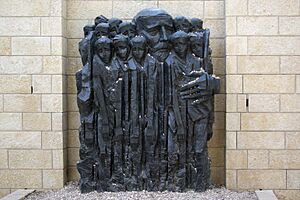
One of Yad Vashem's important jobs is to honor non-Jewish people. These individuals risked their lives to save Jews during the Holocaust. A special group of people, including historians and survivors, reviews each case. They follow clear rules to decide who gets this honor.
Those recognized as "Righteous Among the Nations" receive a special certificate and a medal. Their names are also remembered in the Garden of the Righteous Among the Nations at Yad Vashem. This project is ongoing. As of 2021, more than 27,921 people have been recognized.
Art Gallery
Yad Vashem has the world's largest collection of art made by Jews and other victims. This art was created during the Nazi occupation from 1933 to 1945. The Art Department at Yad Vashem manages a collection of 10,000 pieces. They add about 300 new pieces each year. Most of these are given by survivors' families or found in old homes. The collection includes works by artists like Alexander Bogen and Felix Nussbaum.
Monuments at Yad Vashem
Yad Vashem has several important monuments:
- The monument to the heroes of the Warsaw Ghetto Uprising. This is a version of the famous monument in Warsaw.
- The Janusz Korczak and the Children memorial. This remembers the educator who refused to leave the children he cared for.
- A memorial for the Jewish children murdered in the Holocaust.
- The Memorial to the Deportees, also called the "train monument." It remembers Jews taken to death camps in cattle cars.
- Valley of the (Destroyed) Communities. This monument remembers the thousands of Jewish communities in Europe that were destroyed.
Awards and Recognition
Yad Vashem has received many important awards for its work.
- In 1973, its project to document Jewish communities won the Israel Prize.
- In 2003, Yad Vashem itself won the Israel Prize for its lifetime achievements.
- In 2007, it received the Prince of Asturias Award for Concord. This award honors work that helps understanding and peace among people.
- Also in 2007, Yad Vashem Chairman Avner Shalev received the French Légion d'honneur. This was for his great work in remembering the Holocaust worldwide.
See also
 In Spanish: Yad Vashem para niños
In Spanish: Yad Vashem para niños
- International Holocaust Remembrance Day
- List of Holocaust memorials and museums
- Yom HaShoah – Israel's Holocaust remembrance day


